

WORLDWIDE DX CLUB TopNews. Beginner Antennas. Antenna size depends on the frequency you want to hear: higher frequency (bigger number) - smaller antenna.
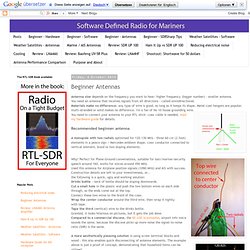
You need an antenna that receives signals from all directions - called omnidirectional.Materials make no difference: any type of wire is good, as long as it keeps its shape. Metal coat hangers are popular, multi-stranded or solid makes no difference. I'm a fan of No 10 house grounding wire. You need to connect your antenna to your RTL stick: coax cable is needed, read my hardware guide for details. Recommended beginner antenna A monopole with two radials optimised for 120-130 MHz - three 60 cm (2 foot) elements in a peace sign / Mercedes emblem shape, coax conductor connected to vertical element, braid to two sloping elements. Sangean ATS-909/Radio Shack DX-398 FAQ: Modifications.
Taking it apart The following modifications are courtesy of Rick.

<rickw999@aol.com> and are reproduced with permission from his web site. Unplug the power, antenna, headphone and tape connections.Remove the volume, manual tuning and RF gain knobs by pulling them straight off away from the radio. Be careful not to bend the shafts.Move the whip antenna out of the clipped holding position so that the small screw can be removed from the antenna compartment. Use a small Phillips head screwdriver for this.On the back of the radio, there are five holes with arrows pointing towards each screw. Anti-chuffing Modification Once the back is off, look down on the left side of the board under the tuning knob. Hacker's Guide to the Sangean ATS-909/Radio Shack DX-398 Memory System. The ATS-909 Memory Circuit The following is courtesy of Jim Bowlin: As has been suggested in this group in the past, the "Data In" connections on the bottom of the DX-398/AT-909 are indeed connected to a nonvolatile memory chip that holds all the preset information.
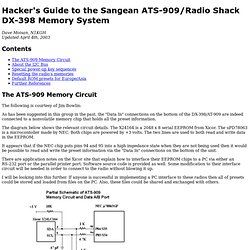
The diagram below shows the relevant circuit details. The X24164 is a 2048 x 8 serial EEPROM from Xicor. The uPD78063 is a microcontoller made by NEC. It appears that if the NEC chip puts pins 94 and 95 into a high impedance state when they are not being used then it would be possible to read and write the preset information via the "Data In" connections on the bottom of the unit. Glenn Hauser's World of Radio. Radiojayallen. DE-1103 and PL-660. Shortwave Radio Index. Portable radios are, by far, the most popular category of shortwave radio on the market today. These days, portables pack a big punch, are loaded with features and are quite affordable.
Below, you will find a list of all portable radios categorized by manufacturer. Click on the radio name and model to view details. IARU Region1 Monitoring System. Euro-African Medium Wave Guide. RX-SSTV: Freeware SSTV Program, By ON6MU. RX-SSTV version v1.3.1 release february 2013 A Windows SSTV receiving program specially designed for SWL's It's compact, It's handy, It's powerfull, It's easy to use and It's FREE!
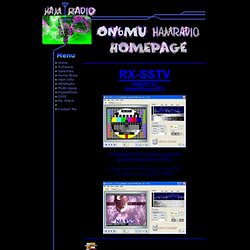
Shortwave Central. Image Communication on Short Waves – SSTV, WEFAX, HamDRM. DX/SWL/Media Programs. DXing.com Web Resource for shortwave, scanner and ham radio hobbyists. DXing.com Web Resource for shortwave, scanner and ham radio hobbyists. WORLDWIDE DX CLUB. ELAD Receptor SDR FDM-S1 en Astro Radio S.L. TECSUN_PL-660_user. RS-DX398. Sangean 909 Radio Shack DX398. Www.hard-core-dx.com Mailing Lists.
QSL ESPECIAL LA GUERRA DE LOS MUNDOS RHC. El domingo 27 de octubre, en el programa DX “En Contacto” de Radio Habana Cuba, tendrá un segmento “especial” con la adaptación de la radionovela “La Guerra de los Mundos” de Orson Welles, al cumplirse el 30 de ese mes 75 años de ese acontecimiento donde Welles hizo creer a los estadounidenses que miles de extraterrestres invadían la tierra. Setenta y cinco años después nadie ha hecho un guión tan real que hacía confundir la ficción y la realidad.
A los oyentes que reporten este programa recibirán esta QSL “especial” que adjuntamos, conmemorativa de esa efeméride. Estos son los horarios y frecuencias del programa: Vigente hasta octubre 2013 9540 Khz (31 metros) 11690, 11750, 11760 y 11860 Khz (25 metros) The Reception Report. The following page is based on Radio Netherlands' pamphlet «writing useful reception reports».
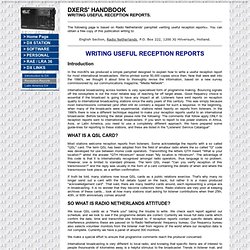
You can obtain a free copy of this publication writing to: English Section, Radio Netherlands, P.O. Box 222, 1200 JG Hilversum, Holland. Introduction In the mid-80's we produced a simple pamphlet designed to explain how to write a useful reception report for most international broadcasters. International broadcasting across borders is very specialised form of programme making. Reporting and QSLs. "QSL" is the radiotelegraph code meaning "I confirm.
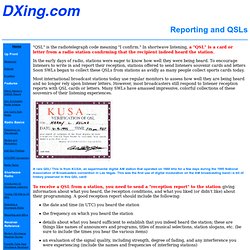
" In shortwave listening, a "QSL" is a card or letter from a radio station confirming that the recipient indeed heard the station. In the early days of radio, stations were eager to know how well they were being heard. To encourage listeners to write in and report their reception, stations offered to send listeners souvenir cards and letters Soon SWLs began to collect these QSLs from stations as avidly as many people collect sports cards today.
Most international broadcast stations today use regular monitors to assess how well they are being heard and no longer rely upon listener letters. However, most broadcasters still respond to listener reception reports with QSL cards or letters. A rare QSL! To receive a QSL from a station, you need to send a "reception report" to the station giving information about what you heard, the reception conditions, and what you liked (or didn’t like) about their programming. Glenn Hauser's World of Radio. WoR - Hitlist. WoR - Hitlist.